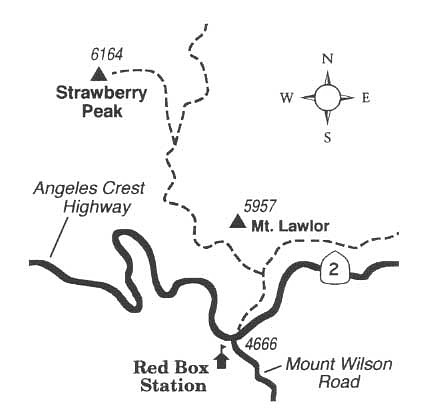 Facebook
Facebook
 X
X
 Instagram
Instagram
 TikTok
TikTok
 Youtube
Youtube
Strawberry Peak's 6164-foot summit claims the honor of being the highest elevation in the "Front Range" of the San Gabriel Mountains -- the range closest to the San Gabriel Valley and the Los Angeles Basin. In March 1909, Strawberry Peak garnered national attention when a gas balloon and gondola carrying six passengers over Tournament Park in Pasadena was swept by violent gusts into storm clouds over the San Gabriel Mountains. After being tossed to as high as 14,000 feet, the balloon descended in white-out conditions and crash-landed just below Strawberry's snow-covered summit -- its gondola coming to rest just ten feet from a vertical precipice. Nearly three days later, a telephone call from a remote outpost in the mountains brought news to the world below that the riders had survived.
Hikers can reach Strawberry's summit in as little as 3.3 miles one-way distance, with a net elevation gain of 1500 feet along the way. Park at Red Box Gap, 14 miles east of I-210 in La Canada via the Angeles Crest Highway. The Red Box site, a major intersection point of historic trails (and more recently paved roads), was named for a red box of fire-fighting tools placed there around 1908. A ranger station and picnic facilities now occupy the site.
From Red Box, walk east along the left shoulder of Angeles Crest Highway 0.1 mile to an abandoned fire road slanting left up the hillside. Continue up the eroded bed of that road for 0.6 mile to reach a trail on the left. From there, follow switchbacks through chaparral northwest to a saddle due south of Mt. Lawlor's summit. Afterward, the trail gains elevation very gradually.
When you reach a saddle on the northwest shoulder of Mt. Lawlor (2.2 miles from Red Box) and the trail starts to descend north, leave the maintained trail and start climbing along the overgrown fire break slanting left along an undulating, chaparral-covered ridge. Work your way north and finally west to Strawberry's shaggy-looking summit -- rocky and slippery going in places.
Scattered Coulter pine trees (renowned for their massive cones) and scrappy bigcone Douglas-fir trees struggle for existence near the summit, their wind-blown limbs swept back in gestures of defiance. The view from the top is panoramic, and sometimes mysterious, as when Strawberry basks in clean air while lower ramparts are wreathed in a moist marine layer or in a blanket of smog.


Strawberry Peak's 6164-foot summit claims the honor of being the highest elevation in the "Front Range" of the San Gabriel Mountains -- the range closest to the San Gabriel Valley and the Los Angeles Basin. In March 1909, Strawberry Peak garnered national attention when a gas balloon and gondola carrying six passengers over Tournament Park in Pasadena was swept by violent gusts into storm clouds over the San Gabriel Mountains. After being tossed to as high as 14,000 feet, the balloon descended in white-out conditions and crash-landed just below Strawberry's snow-covered summit -- its gondola coming to rest just ten feet from a vertical precipice. Nearly three days later, a telephone call from a remote outpost in the mountains brought news to the world below that the riders had survived.
Hikers can reach Strawberry's summit in as little as 3.3 miles one-way distance, with a net elevation gain of 1500 feet along the way. Park at Red Box Gap, 14 miles east of I-210 in La Canada via the Angeles Crest Highway. The Red Box site, a major intersection point of historic trails (and more recently paved roads), was named for a red box of fire-fighting tools placed there around 1908. A ranger station and picnic facilities now occupy the site.
From Red Box, walk east along the left shoulder of Angeles Crest Highway 0.1 mile to an abandoned fire road slanting left up the hillside. Continue up the eroded bed of that road for 0.6 mile to reach a trail on the left. From there, follow switchbacks through chaparral northwest to a saddle due south of Mt. Lawlor's summit. Afterward, the trail gains elevation very gradually.
When you reach a saddle on the northwest shoulder of Mt. Lawlor (2.2 miles from Red Box) and the trail starts to descend north, leave the maintained trail and start climbing along the overgrown fire break slanting left along an undulating, chaparral-covered ridge. Work your way north and finally west to Strawberry's shaggy-looking summit -- rocky and slippery going in places.
Scattered Coulter pine trees (renowned for their massive cones) and scrappy bigcone Douglas-fir trees struggle for existence near the summit, their wind-blown limbs swept back in gestures of defiance. The view from the top is panoramic, and sometimes mysterious, as when Strawberry basks in clean air while lower ramparts are wreathed in a moist marine layer or in a blanket of smog.
